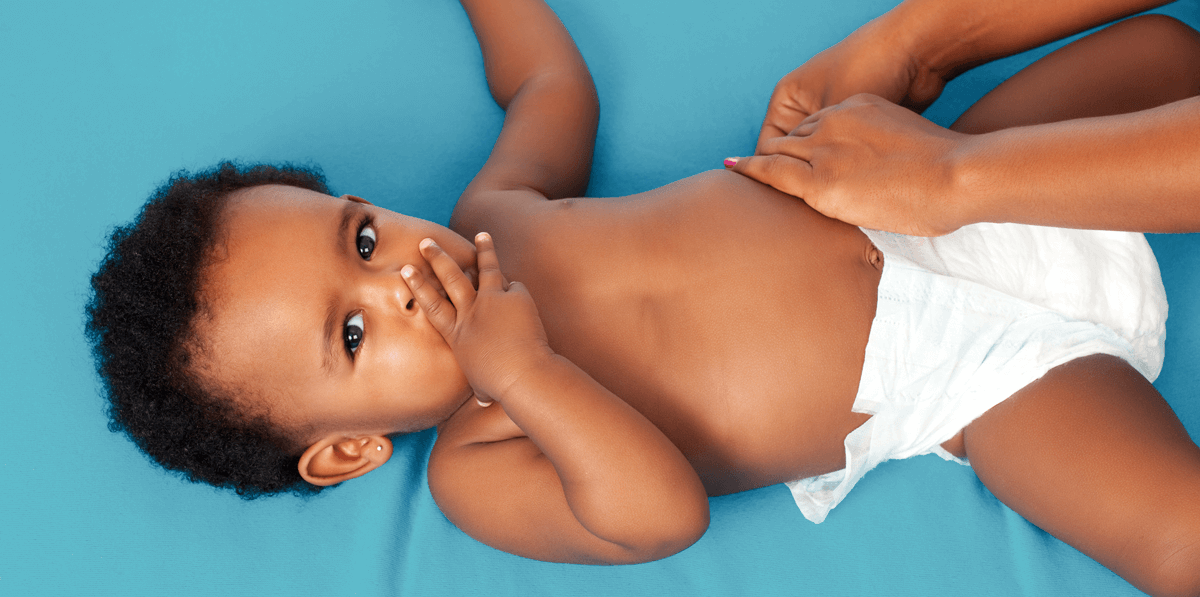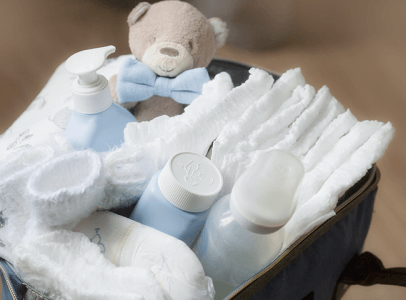Diaper Rash: Tips for Treatment and Prevention
Every parent of a newborn knows about the dreaded diaper rash. It’s so common that diaper rash cream is often found on baby registries. Even if you use diapers that are super absorbent and you change them frequently, it’s likely your infant will experience a diaper rash at some point.
Below, we’ll go over what a diaper rash is, how to recognize the symptoms, how to treat them, and how to prevent diaper rashes from reoccurring.
What is diaper rash?
Diaper rash is a skin condition that is common among babies, but can affect anyone who regularly wears a diaper. It’s characterized by red inflamed skin on the bottom and areas covered by the diaper. It’s typically caused when the skin is exposed to urine or poop for too long.
Diaper rash is irritating and uncomfortable for babies. Most cases are mild and can be cleared up at home without needing to see a doctor. Typical at-home treatments include more frequent diaper changes, air drying before putting on new diapers, and OTC diaper rash ointments or creams. Babies with sensitive skin may be more prone to diaper rashes.
What are the causes of diaper rash?
Diaper rash is most often caused by the following:
-
Infrequent diaper changes: if your baby’s skin is exposed to urine or poop for long periods, it may lead to diaper rash. The time varies by child and how sensitive their skin is.
-
Improperly fitted diapers: If the diaper is too tight, the edges can rub against your baby’s skin and cause diaper rash, chafing, and skin irritation.
-
Allergic reactions: Your baby may develop a diaper rash if they’re allergic to an ingredient in the diaper, baby wipes, laundry detergent, lotion, or any products that come in contact with their skin. A diaper rash could also be the result of an allergic reaction to food. If you’re exclusively breastfeeding, it could be due to something you ate.
-
Introducing solids: When you introduce solid foods to your baby, their poop will change in content and frequency. This could lead to a diaper rash.
-
Medication: If you take a prescription medication while breastfeeding, it could impact your breastmilk, which could impact your baby’s stool. This is especially true for antibiotics. If your infant has to take antibiotics, this could also impact the bacteria in their poop, which may lead to a diaper rash.
What are the symptoms of diaper rash?
It’s important to know the symptoms of diaper rash so you can recognize them and treat them accordingly.
Here are the most common signs of diaper rash:
-
Red skin around the diaper area, on the bottom, or in the folds of the upper thighs
-
Red bumps in the diaper area
-
Peeling or flaking skin
-
Scaly and rough patches of skin
-
Skin feels warm to the touch
More serious diaper rash symptoms include:
-
Blisters (may be filled with pus)
-
Open sores
-
Red patches that ooze fluid or pus
What are the different types of diaper rash?
Irritant dermatitis
This type of diaper rash is the most common and is caused by irritants — namely urine and poop — and rubbing and chafing from moving around in diapers. It impacts the genitals, bottom, thighs, and stomach.
Candida dermatitis
Candida dermatitis is caused by yeast. It’s usually a deep red color and shows up in patches all over the diaper area, in the creases of the thighs, and sometimes even spreads outside of the diaper area. If you think yeast is the cause, check your baby’s mouth for thrush, a yeast infection that occurs in the mouth.
Yeast-related diaper rashes are typically linked to taking antibiotics, either by the baby or by the breastfeeding mother.
Allergic dermatitis
Allergic dermatitis is related to an allergic reaction to the diaper or baby wipes. It could be the material or an ingredient. It could also be caused by the laundry detergent you use for their clothes or the lotion or cream you use during diaper changes. If you’re nursing, it could be related to something you eat.
Allergic reactions don’t always happen immediately. Keep in mind it can take up to three weeks to see a skin reaction after an initial exposure.
Bacterial dermatitis
This type of diaper rash is caused by bacteria — most commonly group A Streptococcus and Staphylococcus aureus bacteria. Symptoms that indicate bacterial dermatitis include pus, blisters, bleeding, fever, and lethargy. Call your pediatrician if you suspect a bacterial infection as you’ll likely need antibiotics to treat it.
What are the treatments for diaper rash?
Diaper rash treatments at home typically involve changing diapers more frequently and using an OTC cream or jelly. Most diaper rashes are mild and can be treated with creams and ointments available at your local grocery and drug store (CVS and Walgreens) or big box retailer (Target and Walmart) and club store (Costco and Sam’s Club).
Diaper-changing tips
-
One of the most effective ways to treat and prevent diaper rash is to change soiled diapers more frequently. If possible, it’s best to change the diaper each time it’s soiled, even if it’s just urine. Minimizing skin contact with urine and poop is helpful in preventing diaper rash from reoccurring.
-
Use the most absorbent disposable diapers available to help keep the diaper area as dry as possible for the times you can’t immediately change the diaper.
-
After using baby wipes, make sure the diaper area is dry before putting on a new diaper. Putting a diaper on wet or damp skin may cause diaper rash. Avoid using baby powder or cornstarch to dry the area because the powder can be inhaled by your baby and it could harm their lungs.
-
If using cloth diapers, use a fragrance-free laundry detergent and rinse thoroughly with clear water to remove all soap residue. Make sure they’re completely dry prior to using again.
-
Dress your baby in cool, breathable clothing that isn’t tight or constricting.
Diaper rash creams and ointments
Many companies offer creams and ointments that can help soothe irritated skin and provide a barrier to urine and poop. Some popular brands include Desitin, Triple Paste, Boudreaux’s Butt Paste, Aquaphor, and Vaseline.
Diaper rash prescription remedies
If the diaper rash is bacterial, see your pediatrician to get a prescription for topical or oral antibiotics. Make sure to follow the instructions for the full course of treatment.
How can I prevent diaper rash?
While there’s no way to 100% prevent diaper rash, there are steps you can take to minimize the chances of them from happening. Some of these tips are similar to the treatments described above.
-
Use chemical-free dye-free super absorbent diapers
-
Make sure the diaper fits properly (not too tight); if in doubt, size up.
-
Change diapers immediately each time it’s soiled, including overnight.
-
Use fragrance-free hypoallergenic alcohol-free baby wipes that contain no chemical additives or preservatives.
-
Pat the diaper area dry or let it air dry before putting on a new diaper.
-
Dress your baby in loose, breathable clothing. If possible, let them go without pants at home.
-
Apply barrier cream or ointment over the diaper area to shield your baby’s skin from moisture even when they don’t have a diaper rash.
-
Allow diaper-free time at home. Lay a thick towel over tiles or hard floors in case there’s an accident and let your baby play for 10-30 minutes sans diaper.
-
Monitor your diet (if you’re breastfeeding) and your baby’s diet (if they’re on solids).
When do I need to see a doctor for diaper rash?
Most cases of diaper rash are mild and can be cleared up within a few days with at-home treatments. If it doesn’t improve by then, or gets worse, call your pediatrician to make sure it isn’t something more serious or to determine whether a stronger treatment is necessary. If you suspect a bacterial infection, call the doctor.
How can baby wipes help with diaper rash?
While diaper rashes are linked to wearing diapers and how frequently they’re changed, baby wipes are part of the diaper changing process and can play a role in helping to minimize the chances of diaper rashes.
Diaper rashes are most often associated with extended skin contact with urine and poop, but they can also be caused or exacerbated by excess moisture from a baby wipe. Water is the number one ingredient of baby wipes — and water is essential to cleaning and wiping during diaper changes — but if your baby wipes are too wet, you may inadvertently be creating a moist environment when you put a diaper back on. And that moist environment could contribute to diaper rash or other skin irritation.
Moisture level varies by brand so try out a few to determine which brand has the right balance of moisture. You want one that is wet enough for effective cleaning, but not so wet that you have to get a towel to pat the area dry before putting on a fresh diaper. (Keep in mind that most daycare providers won’t have time for this added step.)
You also want a baby wipe that is durable and strong enough to handle diaper blowouts, while also being gentle and soft on your baby’s delicate skin.
Other things to consider are the cleansing ingredients. Make sure that the wipes are hypoallergenic, alcohol-free, and free of parabens and phthalates. Even better are ones that take the environment into consideration and are plastic-free and made from renewable plant-based fibers, such as Nice ’N CLEAN® BABY Wipes.
ALSO READ: How to Choose the Best Baby Wipes for your Child
Nice ’N CLEAN® BABY Wipes were specially developed to meet all of your baby cleaning needs so you can trust our wet wipes to clean effectively while also being soothing and gentle.
References:
-
Mayo Clinic: Diaper Rash: Symptoms and Causes
-
Healthline: How to Recognize and Treat Different Types of Diaper Rash
-
Pediatric Dermatology: The science behind wet wipes for infant skin: Ingredient review, safety, and efficacy
-
Healthline: Tips for Treating Diaper Rash





